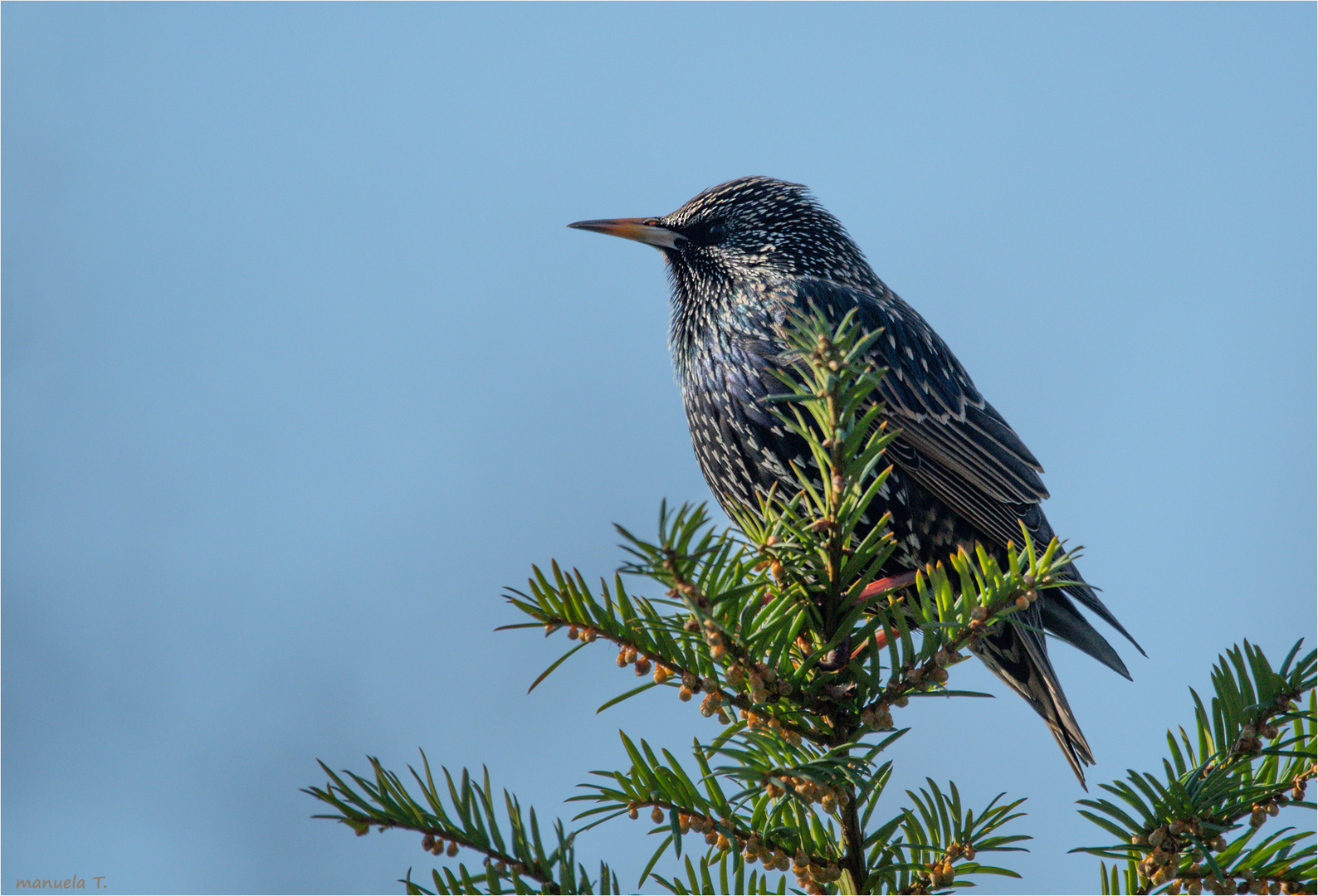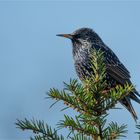Common starling
Common starling / Star
Sturnus vulgaris
Back to our native birds.
The starling (Sturnus vulgaris), also known as the common starling, is the most widespread and common member of the starling family (Sturnidae) in Eurasia. Due to numerous naturalisations on other continents, the starling is now one of the most common birds in the world. The song is usually performed all year round from an exposed position, during the breeding season usually in the immediate vicinity of the breeding cavity. Intensively singing starlings ruffle their feathers and flap their spread wings. The starling is famous for its "mocking", i.e. its ability to imitate animal voices and sounds. The sustained, chattering song consists of a variety of rising or falling whistles, snaps, hisses and rattles, as well as imitations of bird and other animal voices or technical sounds. For example, the calls of quail, buzzard or lapwing are often imitated, as well as the barking of dogs, the sound of lawnmowers or, more recently, mobile phone ring tones. The warning calls vary depending on the threat. Starlings move all year round in groups and sometimes in huge flocks. Starlings are territorial only at the breeding site, usually defending a small radius of up to about 10 m around the breeding cavity. Feeding areas are not defended but shared. Non-breeders also live in groups during the breeding season. Starling flocks, sometimes numbering more than 1 million individuals, have caused considerable feeding damage, especially in wine-growing areas, but also in cherry orchards and olive groves. In some cases, the large roosts have also been perceived as a nuisance due to the noise and the quantities of faeces produced. There is also a sweet cherry tree in my garden and if I'm lucky I get a couple of cherries if I'm faster than the starlings. I could put up a net, but I don't want to, I'm afraid a bird could get caught in it.
Wieder zurück zu unseren heimischen Vögeln.
Der Star (Sturnus vulgaris), auch als Gemeiner Star bezeichnet, ist der in Eurasien am weitesten verbreitete und häufigste Vertreter der Familie der Stare (Sturnidae). Durch zahlreiche Einbürgerungen auf anderen Kontinenten ist der Star heute einer der häufigsten Vögel der Welt. Der Gesang wird ganzjährig meist von einer exponierten Warte vorgetragen, während der Brutzeit meist in unmittelbarer Nähe zur Bruthöhle. Intensiv singende Stare sträuben das Gefieder und flattern mit den gespreizten Flügeln. Der Star ist für sein „Spotten“ berühmt, also für seine Fähigkeit, Tierstimmen und Laute zu imitieren. Der anhaltende, schwätzende Gesang besteht aus einer Vielzahl von ansteigenden oder abfallenden Pfeiftönen, Schnalz-, Zisch- und Rätschlauten sowie Imitationen von Vogel- und anderen Tierstimmen oder technischen Geräuschen. Häufig werden zum Beispiel Rufe von Wachtel, Mäusebussard oder Kiebitz nachgeahmt, daneben auch Hundegebell, das Geräusch von Rasenmähern oder neuerdings auch Klingeltöne von Mobiltelefonen. Die Warnrufe sind je nach Bedrohung unterschiedlich. Stare bewegen sich ganzjährig in Trupps und z. T. riesigen Schwärmen. Nur am Brutplatz ist der Star territorial, meist wird ein kleiner Radius bis ca. 10 m um die Bruthöhle verteidigt. Nahrungsflächen werden nicht verteidigt, sondern gemeinsam genutzt. Nichtbrüter leben auch in der Brutzeit in Trupps. Die zum Teil mehr als 1 Million Individuen umfassenden Starenschwärme haben insbesondere in Weinbaugebieten, aber auch in Kirschplantagen und Olivenhainen erhebliche Fraßschäden verursacht, teilweise wurden auch die großen Schlafplätze durch den Lärm und die anfallenden Kotmengen als Belästigung empfunden. In meinem Garten steht auch ein süß Kirschbaum und wenn ich Glück habe bekomme ich ein zwei Kirschen ab, wenn ich schneller bin als die Stare. ich könnte ein Netz anbringen, aber das möchte ich nicht, habe Angst das sich ein Vogel darin verfangen könnte
Infos Wicki
https://www.deutsche-vogelstimmen.de/star/
taken 2.22





















philipp52 17/02/2023 8:45
im glänzenden Licht schön aufgenommen, ein Star ebenLG Philipp
Marina Luise 16/02/2023 17:50
Danke auch für deine Info - ich musste lachen, dass sie auch Mobiltelefone imitieren! :))Und ich finde es gut, dass du keine Netze spannst - hier verfangen sich tatsâchlich Vögel drin und sterben elend - war mir mal anfangs passiert beim Abdecken von Kopfsalat! ich habe es bitterlich bereut - zwei tote sicher verdurstete Spâtzchen! :(((
Marina Luise 16/02/2023 17:46
Die mag ich sehr und ich freue mich jedes Jahr, wenn sie es wieder geschafft haben und wieder zurückkommen und singen und babbeln! :)Dario Zeller 14/02/2023 19:44
Ein hübscher Bursche.Küster Petra 14/02/2023 7:56
Schön zeigt er die kleinen Herzen in seinem Gefieder. LG PetraTante Mizzi 13/02/2023 22:45
Eine sehr schöne Aufnahme von dem prächtigen Star !!!Ich wünsche Dir eine schöne Woche und bleib gesund!
Liebe Grüße
Mizzi
Adele D. Oliver 13/02/2023 21:59
a great portrait of this starling showing his beautifulmarkings well ... we have a large group of them visiting our
garden daily !!
warm regards.
Adele
H.D. G. 13/02/2023 20:06
Der hat sich ja sehr schön in Pose gestellt dort oben.Gute Schärfe und schöne Farben.
Gruß Dieter
Axel Sand 13/02/2023 18:46
Ein tolles Foto, Manu.Gruß Axel
Vitória Castelo Santos 13/02/2023 16:29
Deine Aufnahme ist klasse !LG Vitoria
Maria Lima Marques 13/02/2023 15:16
Feine Aufnahme der StarLgMaria
patrick hyrailles 13/02/2023 13:36
beau shoot bravoGünter Seng 13/02/2023 13:27
Den Hast du wunderbar fotografiertGruß Günter
Blula 13/02/2023 13:21
Na, der hat sich ja ein richtig sonniges Plätzchen ausgesucht !Und ich habe jetzt hier auch noch viel Wissenswertes über ihn gelesen.
Schön auch, dass Du wieder den entsprechenden Vorgelstimmenlink mit angehängt hast.
LG Ursula
Gaby Falkenberg 13/02/2023 12:50
Sehr gut wirkt der Star vor dem ruhigen Hintergrund,Feinstens kommt hier sein prächtiges Gefieder im schönen Licht zur Geltung.LG.Gaby